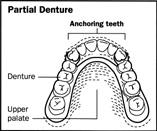Dental Implants & Dentures - Bridges and partial dentures
Bridges and Partial Dentures
Several different types of dental appliances may be constructed to fill empty spaces. Some, such as dental bridges, may be cemented to the remaining natural teeth. Others, such as complete sets of dentures, are removable.

A bridge may be made entirely of gold, a combination of gold and porcelain, or combinations of gold and porcelain and other materials. If there is a sound natural tooth on either side of the space, an artificial tooth (or pontic ) may be fused to the metal bridge. The crown retainer on either side of the pontic may then be cemented to crowns of the neighboring natural teeth.
If there are no natural teeth near the space created by an extracted tooth, a partial denture may be constructed to replace the missing teeth. This appliance usually fastens by a clasp onto the last tooth on each side of the space. A bar on the inside of the front teeth provides stability for the partial denture. A “Maryland bridge,” a fixed partial denture, eliminates the need for crowns to anchor false teeth.
A removable partial denture should be taken out and cleaned with special brushes whenever the natural teeth are brushed. Your dentist should check bridges and partial dentures periodically to make sure they have not become loosened. A loose clasp of a partial denture can rock the teeth to which the device is attached, causing damage and possible loss.
New materials have brought bonding into more common use as an alternative to crowning and for cosmetically restoring chipped, malformed, stained, or widely spaced teeth. In the bonding process the dentist applies first liquid plastic and then thin layers of tooth-colored materials known as composite resins and laminate veneers. The layers are sculpted and polished.

Comment about this article, ask questions, or add new information about this topic: